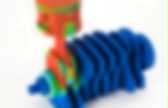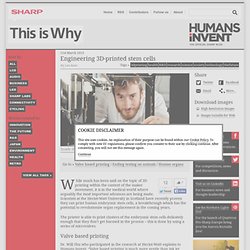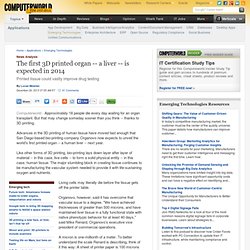

3D printing mechanical hands. 3-D printer makes prosthetic hand. Engineering 3D-printed stem cells. Inside the stem cell printer.

While much has been said on the topic of 3D printing within the context of the maker movement, it is in the medical world where arguably the most important advances are being made. Scientists at the Heriot-Watt University in Scotland have recently proven they can print human embryonic stem cells, a breakthrough which has the potential to revolutionise organ replacement in the coming years. The printer is able to print clusters of the embryonic stem cells delicately enough that they don’t get harmed in the process – this is done by using a series of microvalves. Valve based printing Dr. The cells maintained their important biological function of pluripotency Maintaining the pluripotency of each cell is key because this will allow for stem cells to make any type of organ or tissue and while 3D printing cells has been achieved previously, Dr.
Dr. Ending drug testing on animals. Patient has 75 per cent of his skull replaced by 3D-printed implant. Printable Human Organs Closer. 3D printing technology is hot and getting hotter.

Whereas once 3D printers were limited to a few select materials, these days inputs include metal, plastic, glass, wood, and—human cells? Bet you didn’t see that coming. (Actually, if you’re a regular here, you probably did.) Bioprinting firm, Organovo, isn’t anywhere near 3D printing a hand or heart. But a recently announced partnership with 3D modeling software giant Autodesk (maker of AutoCAD) might speed things up a bit. We first encountered Organovo in 2009. But its potential is great. Organovo’s NovoGen MMX Bioprinter. Already bioprinters are capable of printing small parts, like arteries or knee cartilage.
But eventually (years from now) researchers hope to print, not just the piston, but the entire engine—a new heart or lung—customized and made entirely from a patient’s own tissue, limiting the probability of rejection by the body and doing away with long and uncertain waiting periods for donors. That’s where Autodesk comes in. The first 3D printed organ. News Analysis December 26, 2013 07:05 AM ET Computerworld - Approximately 18 people die every day waiting for an organ transplant.

But that may change someday sooner than you think -- thanks to 3D printing. Advances in the 3D printing of human tissue have moved fast enough that San Diego-based bio-printing company Organovo now expects to unveil the world's first printed organ -- a human liver -- next year. Like other forms of 3D printing, bio-printing lays down layer after layer of material -- in this case, live cells -- to form a solid physical entity -- in this case, human tissue. Living cells may literally die before the tissue gets off the printer table. 3D tissue printer that prints cartilage. American scientists have developed a hybrid printer that prints cartilage, which could one day be implanted into injured patients to help re-grow cartilage in areas such as the joints.

The 3D tissue printer, featured in a study published in the journal Biofabrication by the Institute of Physics, is a mix of a traditional ink jet printer and an electrospinning machine. In this study, done by scientists at Wake Forest University in North Carolina, the hybrid system produced cartilage with better mechanical stability than those created by an ink jet printer. “This is a proof of concept study and illustrates that a combination of materials and fabrication methods generates durable implantable constructs,” said Dr. James Yoo, a professor at the Wake Forest Institute for Regenerative Medicine, and an author on the study. Other methods of making cartilage, such as robotic systems, are also being developed to improve implantable tissue. The 'chemputer' that could print out any drug. Professor Lee Cronin is a likably impatient presence, a one-man catalyst.

"I just want to get stuff done fast," he says. And: "I am a control freak in rehab. " Cronin, 39, is the leader of a world-class team of 45 researchers at Glasgow University, primarily making complex molecules. 3D printing cancer drugs molecule-by-molecule, using DNA scaffolds. Imagine designing parts that can self-assemble into a house. Now imagine that these same houses can self assemble into cities. On the nanoscale, as for biomolecules and tissues, this scenario is so commonplace that it hardly deserves mention: Your entire body, and every other living thing on Earth, self-assembled.
If the designer is not the whole of nature itself, however, but a human with a fancy CAD program calling the shots, you might sit up and take notice. A company called Parabon Nanolabs has recently developed a suite of CAD tools and technologies to do just that. A press release from the National Science Foundation describes a new project at Parabon, which it has chosen to fund. Cancer medicines are typically so expensive that a real price per molecule can be discussed using familiar numbers. Parabon’s InSequio design studio enables drug designers to build up molecules step-by-step from drag-and-drop menus, and quantify them in the process. The DNA itself is not the drug.